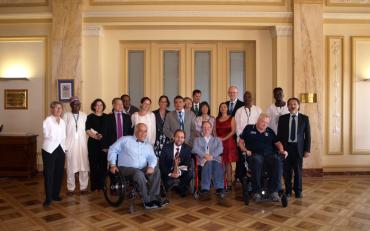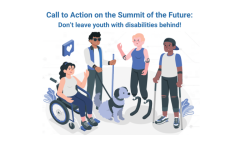Originally published at the Huffington Post: http://www.huffingtonpost.com/entry/58473671e4b0cc9e7cf5dbdd?timestamp=1...
Ten years ago the UN Convention of the Rights of Persons with Disabilities (CRPD) was adopted. It was the first internationally legally binding instrument to specifically address the rights of persons with disabilities at a global level. It was achieved with the active participation of the disability rights movement. This set a new standard for civil society involvement in UN negotiations. Diane Richler, former Chair of the International Disability Alliance (IDA), and Past-President of Inclusion International, remembers this as “not just a victory for disability rights, it marked a high point in solidarity and collaboration within the whole disability community”.
“Deaf persons were advocating for the rights of persons with psychosocial disabilities, persons with psychosocial disabilities were advocating for accessible technology for Blind persons, men and women with disabilities were fighting together for gender equity – it gave a sense that collaborative advocacy across countries, contexts and communities is possible” recalled Lisa Adams, who today works with the Disability Rights Fund.
The process of negotiating this convention was far faster than other human rights treaties. Stefan Tromel, former Executive Director of IDA, now a Senior Disability Specialist with the International Labour Organization, who also represented the disability rights movement during the negotiations, credits this to the “insistence of organizations of persons with disabilities to immediately start on implementation after it was adopted”.
After ten years building on the galvanizing impact of the agenda, there is much for us all to celebrate about the achievements of the community, which were forged from this process. However - as always - there is still more to be done.
Since its adoption, the CRPD has raised awareness about disability as both a matter of human rights and of development. It also marks a paradigm shift, where persons with disabilities were no longer viewed as objects of charity but as active members of societies, in charge of their own lives, with free and informed consent and with the same rights to participation, engagement and inclusion, as everyone.
This is why, as negotiations began around the new global sustainable development framework to follow the Millennium Development Goals (MDGs), the CRPD was used as a foundation by many disability organisations, including the International Disability Alliance (IDA) and the International Disability and Development Consortium (IDDC), to lobby for the inclusion of persons with disabilities in international development policy. The movement came together to ensure that when “leave no one behind” was adopted by the UN as an overall mantra for the new Sustainable Development Goals (SDGs) – that this included persons with disabilities in a meaningful and measurable way. It marked a huge step forwards from the MDGs, where the evidence shows that people with disabilities were systematically excluded.
Today, by overlaying the CRPD with the SDGs, countries have clearer paths towards including the rights of persons with disabilities throughout implementing their national development programmes.
The challenge is that both the SDGs and the CRPD are hugely ambitious agendas. They bring together progressive perspectives on development, environment, humanitarian response and climate, and rely on a world open to multilateral cooperation, one where nations are outward looking and are supportive of global responses to global problems. Not a world which looks inwards and seeks narrow self-interested relationships, which has in the past fuelled an arms race, not the human race. The resourcing and political commitment to the CRPD and the SDGs have to be forthcoming for the rights of persons with disabilities to be continuously realized to herald a new era of ‘leaving no one behind’.
Despite huge leaps forward in the inclusion of persons with disabilities in the last ten years, there often remains an assumption that persons with disabilities will automatically participate in development programs. It is increasingly recognized that persons with disabilities do not benefit from global development unless their participation is proactively planned for and resourced from the start. Removing the barriers to participation and unlocking the vast potential of persons with disabilities is critical to addressing global poverty reduction, and empowering people to access their rights and actively participate in all aspects of society.
To date 170 States, and the European Union, have ratified the Convention. Progress is accelerating, with the Antigua and Barbuda, Sri Lanka, Brunei Darussalam, Finland, Comoros, the Netherlands, Iceland, and the Central African Republic ratifying in 2016, as well as Belarus and Somoa ratifying in just the last week.
Today IDA and IDDC, the two largest global networks of disability rights organisations, are calling on every remaining UN Member State to ratify or accede to the CRPD, in respect of the ten-year anniversary of this critical convention and in recognition of the one billion persons with disabilities, worldwide, who are often marginalised, excluded or prevented from contributing to the development of their households, communities and countries.
The CRPD is an opportunity to accept and implement a global norm – the rights of people with disabilities – which, as it is realized, advances social, economic and developmental rights for everyone in all societies. A norm which Mr. Tromel believes could deliver a “huge shift from the view of persons with disabilities as passive recipients of benefits, to progressive social protections”. If governments seize this opportunity they will harness the talents and potential of this whole generation to fully contribute to their communities. This transformation is realistic but it does require strong national commitments to multilateral solutions and rights-based approaches to development.
We believe this is a real possibility in this new era - where a convention, ratified by a huge number of countries, is aligned with an inclusive global development framework that will take us through to 2030. Never before has there been such momentum within the disability community. Failure to take advantage of this critical opportunity would not be forgiven by the generations to come.
If we want global change that truly benefits everyone, the international community must act now to make disability-inclusive development a reality. This is the world we demand.

